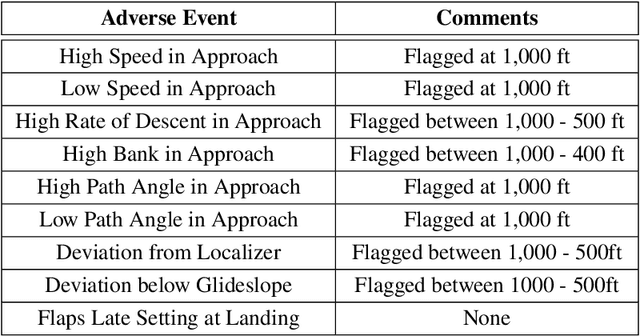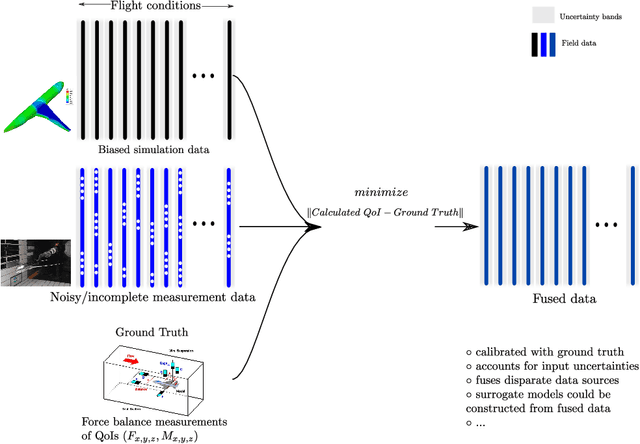Dimitri N. Mavris
ASDL, Daniel Guggenheim School of Aerospace Engineering, Georgia Institute of Technology, Atlanta, Georgia
A Methodology to Identify Physical or Computational Experiment Conditions for Uncertainty Mitigation
May 22, 2024Abstract:Complex engineering systems require integration of simulation of sub-systems and calculation of metrics to drive design decisions. This paper introduces a methodology for designing computational or physical experiments for system-level uncertainty mitigation purposes. The methodology follows a previously determined problem ontology, where physical, functional and modeling architectures are decided upon. By carrying out sensitivity analysis techniques utilizing system-level tools, critical epistemic uncertainties can be identified. Afterwards, a framework is introduced to design specific computational and physical experimentation for generating new knowledge about parameters, and for uncertainty mitigation. The methodology is demonstrated through a case study on an early-stage design Blended-Wing-Body (BWB) aircraft concept, showcasing how aerostructures analyses can be leveraged for mitigating system-level uncertainty, by computer experiments or guiding physical experimentation. The proposed methodology is versatile enough to tackle uncertainty management across various design challenges, highlighting the potential for more risk-informed design processes.
A Multi-Fidelity Methodology for Reduced Order Models with High-Dimensional Inputs
Feb 26, 2024Abstract:In the early stages of aerospace design, reduced order models (ROMs) are crucial for minimizing computational costs associated with using physics-rich field information in many-query scenarios requiring multiple evaluations. The intricacy of aerospace design demands the use of high-dimensional design spaces to capture detailed features and design variability accurately. However, these spaces introduce significant challenges, including the curse of dimensionality, which stems from both high-dimensional inputs and outputs necessitating substantial training data and computational effort. To address these complexities, this study introduces a novel multi-fidelity, parametric, and non-intrusive ROM framework designed for high-dimensional contexts. It integrates machine learning techniques for manifold alignment and dimension reduction employing Proper Orthogonal Decomposition (POD) and Model-based Active Subspace with multi-fidelity regression for ROM construction. Our approach is validated through two test cases: the 2D RAE~2822 airfoil and the 3D NASA CRM wing, assessing combinations of various fidelity levels, training data ratios, and sample sizes. Compared to the single-fidelity PCAS method, our multi-fidelity solution offers improved cost-accuracy benefits and achieves better predictive accuracy with reduced computational demands. Moreover, our methodology outperforms the manifold-aligned ROM (MA-ROM) method by 50% in handling scenarios with large input dimensions, underscoring its efficacy in addressing the complex challenges of aerospace design.
Aircraft Environmental Impact Segmentation via Metric Learning
Jun 24, 2023Abstract:Metric learning is the process of learning a tailored distance metric for a particular task. This advanced subfield of machine learning is useful to any machine learning or data mining task that relies on the computation of distances or similarities over objects. In recently years, machine learning techniques have been extensively used in aviation and aerospace engineering to make predictions, extract patterns, discover knowledge, etc. Nevertheless, metric learning, an element that can advance the performance of complex machine learning tasks, has so far been hardly utilized in relevant literature. In this study, we apply classic metric learning formulations with novel components on aviation environmental impact modeling. Through a weakly-supervised metric learning task, we achieve significant improvement in the newly emerged problem of aircraft characterization and segmentation for environmental impacts. The result will enable the more efficient and accurate modeling of aircraft environmental impacts, a focal topic in sustainable aviation. This work is also a demonstration that shows the potential and value of metric learning in a wide variety of similar studies in the transportation domain.
Scalable Online Learning of Approximate Stackelberg Solutions in Energy Trading Games with Demand Response Aggregators
Apr 04, 2023



Abstract:In this work, a Stackelberg game theoretic framework is proposed for trading energy bidirectionally between the demand-response (DR) aggregator and the prosumers. This formulation allows for flexible energy arbitrage and additional monetary rewards while ensuring that the prosumers' desired daily energy demand is met. Then, a scalable (with the number of prosumers) approach is proposed to find approximate equilibria based on online sampling and learning of the prosumers' cumulative best response. Moreover, bounds are provided on the quality of the approximate equilibrium solution. Last, real-world data from the California day-ahead energy market and the University of California at Davis building energy demands are utilized to demonstrate the efficacy of the proposed framework and the online scalable solution.
Multi-Class Multiple Instance Learning for Predicting Precursors to Aviation Safety Events
Mar 10, 2021



Abstract:In recent years, there has been a rapid growth in the application of machine learning techniques that leverage aviation data collected from commercial airline operations to improve safety. Anomaly detection and predictive maintenance have been the main targets for machine learning applications. However, this paper focuses on the identification of precursors, which is a relatively newer application. Precursors are events correlated with adverse events that happen prior to the adverse event itself. Therefore, precursor mining provides many benefits including understanding the reasons behind a safety incident and the ability to identify signatures, which can be tracked throughout a flight to alert the operators of the potential for an adverse event in the future. This work proposes using the multiple-instance learning (MIL) framework, a weakly supervised learning task, combined with carefully designed binary classifier leveraging a Multi-Head Convolutional Neural Network-Recurrent Neural Network (MHCNN-RNN) architecture. Multi-class classifiers are then created and compared, enabling the prediction of different adverse events for any given flight by combining binary classifiers, and by modifying the MHCNN-RNN to handle multiple outputs. Results obtained showed that the multiple binary classifiers perform better and are able to accurately forecast high speed and high path angle events during the approach phase. Multiple binary classifiers are also capable of determining the aircraft's parameters that are correlated to these events. The identified parameters can be considered precursors to the events and may be studied/tracked further to prevent these events in the future.
Aerodynamic Data Fusion Towards the Digital Twin Paradigm
Nov 02, 2019



Abstract:We consider the fusion of two aerodynamic data sets originating from differing fidelity physical or computer experiments. We specifically address the fusion of: 1) noisy and in-complete fields from wind tunnel measurements and 2) deterministic but biased fields from numerical simulations. These two data sources are fused in order to estimate the \emph{true} field that best matches measured quantities that serves as the ground truth. For example, two sources of pressure fields about an aircraft are fused based on measured forces and moments from a wind-tunnel experiment. A fundamental challenge in this problem is that the true field is unknown and can not be estimated with 100\% certainty. We employ a Bayesian framework to infer the true fields conditioned on measured quantities of interest; essentially we perform a \emph{statistical correction} to the data. The fused data may then be used to construct more accurate surrogate models suitable for early stages of aerospace design. We also introduce an extension of the Proper Orthogonal Decomposition with constraints to solve the same problem. Both methods are demonstrated on fusing the pressure distributions for flow past the RAE2822 airfoil and the Common Research Model wing at transonic conditions. Comparison of both methods reveal that the Bayesian method is more robust when data is scarce while capable of also accounting for uncertainties in the data. Furthermore, given adequate data, the POD based and Bayesian approaches lead to \emph{similar} results.
 Add to Chrome
Add to Chrome Add to Firefox
Add to Firefox Add to Edge
Add to Edge